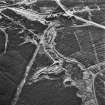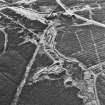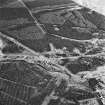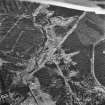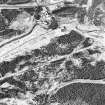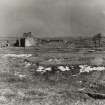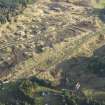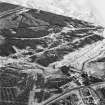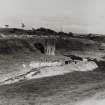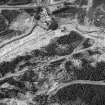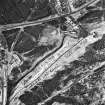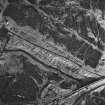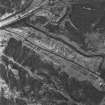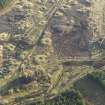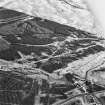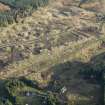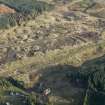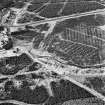Pricing Change
New pricing for orders of material from this site will come into place shortly. Charges for supply of digital images, digitisation on demand, prints and licensing will be altered.
Wilsontown
Archaeological Landscape (18th Century) - (20th Century)
Site Name Wilsontown
Classification Archaeological Landscape (18th Century) - (20th Century)
Alternative Name(s) Wilsontown Ironworks; Mouse Water; Cleugh Estate
Canmore ID 47732
Site Number NS95SE 11
NGR NS 950 549
NGR Description Centred NS 950 549
Datum OSGB36 - NGR
Permalink http://canmore.org.uk/site/47732
- Council South Lanarkshire
- Parish Carnwath
- Former Region Strathclyde
- Former District Clydesdale
- Former County Lanarkshire
NS95SE 11.00 centred on 950 549
(Location cited as NS 951 549). Wilsontown Ironworks, built 1781. The much-ruined remains of this ironworks were demolished in June 1974. They consisted of the front walls of two engine houses, a limekiln, the ruins of a large square blast furnace, a three-arched waggonway bridge, and a section of culvert over the Mouse Water.
J R Hume 1976.
Site recorded during an archaeological evaluation conducted on 30 alternative route elements, with a combined length of c84km, for a proposed road linking the M8 near Whitburn, Lothian Region with the M6/M74 near Douglas, Clydesdale District.
NS 95SE 11 Ironworks complex
An illustrated report will be deposited with the NMRS.
Sponsor: Roads Directorate of The Scottish Office Industry Department, managed on its behalf by Historic Scotland.
A J Dunwell and R J Strachan 1995.
NS95SE 11.00 950 549
Wilsontown Ironworks: Remains of blast furnace, wrought iron works and forge. The main features are two ruined engine-houses; a culvert, which is itself surmounted by a three arched waggonway bridge; a limekiln; foundation remains of forge buildings, managers house and ruins of workers dwellings. The buried square-section blast furnace, with a circular lining, is the only surviving coke blast furnace of the pre-1930 period in Scotland apart from Glenbuck. Now a scheduled ancient monument.
Visited, photographed and filmed by J R Hume, University of Strathclyde, Glasgow, 1965-6.
Information from NMRS MS/749/158.
Field Visit (October 1994 - March 1996)
NS95SE 11.00 centred on 950 549
Extends onto map sheets NS95NW, NS95NE and NS95SW.
NS95SE 11.01 Wilsontown NS 950 549 Ironworks (CSW 1023, 1028, 7026-30, 7033)
NS95SE 11.02 Wilsontown NS 9500 5493 Coke Kilns (CSW 7031)
NS95SE 11.03 Wilsontown NS 9500 5500 Limekilns; Coal Mine (possible) (CSW 1026)
NS95SE 11.04 Wilsontown NS 9513 5491 Workers Row; Building (CSW 1027, 7036)
NS95SE 11.05 Wilsontown NS 9513 5487 Building (CSW 7034)
NS95SE 11.06 Wilsontown NS 9502 5512 Buildings (CSW 1031, 1035-7)
NS95SE 11.07 Wilsontown NS 9507 5517 Workers Rows (CSW 1029, 7019)
NS95SE 11.08 Wilsontown NS 9503 5518 Workers' Row (CSW 7035)
NS95SE 11.09 Wilsontown NS 9507 5526 Public House; Shop (CSW 1030, 1034)
NS95SE 11.10 Wilsontown NS 9500 5529 Workers Rows (CSW 1032)
NS95SE 11.11 Wilsontown NS 9516 5496 to NS 9529 5581 Reservoir; Lade (CSW 1021, 1040)
NS95SE 11.12 Wilsontown NS 952 551 Bell Pits (centred on)
NS95SE 11.13 Wilsontown NS 9528 5536 Workers Row (CSW 1038)
The Wilsontown Ironworks were founded in 1779 on the banks of the Mouse Water to exploit the abundant coal and ironstone resources on the Cleugh estate, the property of Robert Wilson, one of the three brothers who founded the enterprise. The works developed over the following three decades, and a sizeable village rapidly developed around it, housing 400 people by 1794 and nearly 2,000 by 1812, when the company employed 521 men, but managerial failures and costly legal disputes between the owners led the collapse of the company in 1812. William Dixon purchased the business in 1821 and restarted production, but in 1842 the Ironworks were finally closed, although coal mining continued in the area into the middle of the twentieth century. The development and history of the works are discussed by Donnachie and Butt (1965; 1967), Smith (1985) and Ritchie (1938).
The ironworks are now largely reduced to foundations, but the plans of many buildings can be traced. At the core of the site, in the broad flat-bottomed valley of the Mouse Water, there are the remains of two blast furnaces, a forge and other buildings (11.01); above these, to the W, there are traces of coke kilns (11.02) and limekilns (11.03), while to the E and N the foundations survive of several rows of workers' cottages (11.04-06, 11.08), as well as ruins of a later terrace of houses (11.07). To the N again there are the remains of the company stores, shop and inn, the inn still roofed although derelict (11.09), and there are traces of other rows of cottages farther to the NE and NW (11.10, 11.13), as well as one terrace which is still inhabited (Pleasance Row at NS 9480 5524). Spreading up the hillside to the E of the works, on ground now afforested, there are about 70 bell pits (11.12), which presumably supplied the works in its earlier days, and there were numerous other small pits on the moor to the N and E, depicted on the 1st edition of the OS 25-inch map (Lanarkshire 1864, sheets xiv.13 & xiv.14) but no longer visible in dense forestry. Large quantities of water were required at the works, and a reservoir (11.11) survives in the trees to the E of the site, supplied by a lade which ran from another reservoir by the Mouse Water over 800m to the N.
Visited by RCAHMS (SDB) October 1994, March 1996
Management (2001)
Scheduled as Wilsontown Ironworks.
[Scheduled area indicated on map attached to scheduling document].
Information from Historic Scotland, scheduling document dated 9 October 2001.
Publication Account (2009)
The website text produced for Wilsontown Ironworks webpages on the Forest Heritage Scotland website (www.forestheritagescotland.com).
Introduction: The Wilsons of Wilsontown
Wilsontown Ironworks, established in 1779, was one of the first coke-fired blast furnace ironworks in Scotland.
The Wilson brothers, Robert, John and William, built the ironworks to take advantage of the coal and iron ore that was available on their land, the Cleugh estate.
The works grew over the next three decades, and a village developed beside it, with its own shop, school and even a pub.
Unfortunately bad management and family disagreements meant that the company closed down in 1812. The works were re-opened by William Dixon in 1821 but in 1842 the doors of Wilsontown Ironworks closed for the final time.
Today grass covers the small valley where the factory once stood, a quiet spot to enjoy a walk. At first glance it appears that little remains of the ironworks. Wander around the site, however, and you will begin to see traces of what once was in the landscape; the ghost of an industry.
Industrious activity once filled the entire clearing. Imagine the dramatic contrast to today; the large and busy factory with its chimneys bellowing black smoke and the noise of the steam hammers ringing out.
There were hand dug bell pits for mining the ironstone, railways to transport the coal to the factory and rows of housing, one called Quality Row, for the workers and their families.
People story: Famile feuds
Legal documents recording the Wilson family arguments tell the story of the demise of their business.
From the beginning the youngest brother William was concerned about entering into the iron business with his brothers. Despite being in a successful business with his middle brother John, he felt there were risks. Firstly, none of them knew anything about making iron, a complicated and difficult process. Secondly, William had already saved his eldest brother Robert from debt from similar ill thought out ventures in the past.
William was right to be concerned; in 1784 he and John bought Robert out due to his bad management. This should have signalled better times for the ironworks but sadly it did not.
Over the next ten years the brothers' business relationship fell apart.
By 1793 William wanted to close the factory or have John buy his part of the business as it was losing money. John would not allow either. At one point William took a double-barrelled shot gun and threatened Alexander Gunn, the works manager appointed by John,
"with most abusive language calling him 'Buffoon, Villian and Rascal"
1793 court records in Donnachie and Butt (1967) "The Wilsons of Wilsontown Ironworks"
William wanted to see the company's books to show to the court that his investment was being misused. John's foreman and his son, also named John, attempted to prevent this; finally leading to the scene above.
Eventually it was resolved and William left the partnership, while John continued to run the factory with his two eldest sons, William and John, until 1812.
Evidence Story: Wilsontown Ironworks Heritage Project
Since 2002 Emma Stewart, the local Forestry Commission Scotland ranger, has been researching the ironworks in response to the local interest in its history.
In 2007 this led to the launch of the Wilsontown Ironworks Heritage Project. The purpose of the project is to highlight the importance of the site by providing locals and visitors with an understanding of its history and its role within Scotland's industrial heritage.
In pulling together the research on the ironworks the project has developed a picture of industrial operations at Wilsontown. Artist Micheal Blackmore used this information to produce reconstruction drawings showing how the ironworks may have looked and operated in its heyday. These illustrations are excellent tools to help us visualize the past.
More recently helicopters were used on the site to remove trees revealing 77 bell pits. These are shallow mines, dug out by hand, in search of iron ore.
Note (September 2018)
A Brave Enterprise
When William Wilson found that ironstone he may have had no manufacturing experience but he and his brother John were already merchants, importing Swedish bar iron to London. The eldest brother Robert owned the family estate called Cleugh near Forth, close to the boundary with West Lothian. It was a wild and isolated place with a very small resident community. Robert had a small-scale and unsuccessful coal mine on the family estate, so the idea of an Ironworks must have seemed fantastic at the time. However, the 3 brothers set about building Lanarkshire’s first Ironworks and by 1779 they had one furnace in blast.
The Ironworks and its associated village grew over the years. The works included 2 blast furnaces, a forge, rolling mill, coke and calcining kilns, 3 collieries, several quarries, at least 77 bell pits where ironstone was dug up, stables, wrights’, smiths’ and carpenters’ shops and at least 6 miles of iron railway. The village housed over 2000 people at its peak and had a shop, pub and a religious school. Set apart from the works was a new palladian mansion house for the Wilson family. Quite a change to the local landscape.
Over the years there was ongoing investment into the Ironworks with the hope this would yield high returns. Unfortunately a variety of factors led to the bankruptcy of the Wilsons and the Ironworks was put up for sale in 1811. Nobody bought the works until 1821 when it was purchased by William Dixon. It continued as an Ironworks until 1842 when the furnace was finally blown out forever.
A Rethink And A Rebirth
There are the usual famous industrialist names that can be associated with an Ironworks of this age, but perhaps the most significant contribution that Wilsontown Ironworks made is the discovery of hot blast. In 1828 James Beaumont Neilson was working for William Dixon and sent to Wilsontown to fix a leaking water regulator tank. As a result he observed hot blast for the first time and went on to patent this process later that year. This changed iron and steel manufacture forever.
When industry left the place nature gradually recolonised it. Then in the 1960s the Forestry Commission bought the land to establish a new commercial plantation. After initially damaging and destroying significant remains of the Ironworks during 1974 the site saw a turnaround in thinking by the Forestry Commission.
Work began around 2002 to investigate the significance of the Ironworks and plan for its future. It was clear to Forestry Commission Scotland by now that this place mattered a lot to local people and those with family connections to the works. At first the path network saw improvements, then the forest began to be removed from significant areas such as the bell pit landscape. Further path upgrades and an expansion of the car park took place, together with the installing of several artistic features and interpretation boards to tell the stories of this special place. Prof John Hume contributed greatly to the efforts by FCS at this time, his black and white photographs of the site from the 1960s are a significant archive.
Visitors can now explore the place where iron manufacture in Lanarkshire began. As they enjoy the peace here they can wonder at how it once housed 2000 people and was full of noise, flame and smoke.
Emma Stewart - Environment Forester, Forestry Commission Scotland





































































































